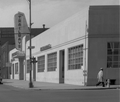Boynton v. Virginia facts for kids
Quick facts for kids Boynton v. Virginia |
|
|---|---|

|
|
| Argued October 12, 1960 Decided December 5, 1960 |
|
| Full case name | Boynton v. Virginia |
| Citations | 364 U.S. 454 (more) |
| Holding | |
| Racial segregation in public transportation is illegal under the Interstate Commerce Act. | |
| Court membership | |
| Case opinions | |
| Majority | Black, joined by Warren, Frankfurter, Douglas, Harlan, Brennan, Stewart |
| Dissent | Whittaker, joined by Clark |
| Laws applied | |
| Interstate Commerce Act | |
Boynton v. Virginia, 364 U.S. 454 (1960), was an important decision by the Supreme Court of the United States. This case helped end racial segregation in travel across different states.
In December 1958, a young law student named Bruce Boynton was traveling by bus from Washington, D.C. to his home in Montgomery, Alabama. During a stop at a bus station in Richmond, Virginia, he went into the restaurant. He sat in the area that was only for white people.
When he refused to move, he was arrested. He was found guilty of breaking a Virginia law. This law said people could not stay somewhere if they were told to leave. Bruce Boynton believed his rights were violated. He argued that his arrest went against the Interstate Commerce Act and parts of the U.S. Constitution.
He took his case to the Supreme Court of Virginia, but they agreed with the lower court. So, he asked the U.S. Supreme Court to hear his case. The U.S. Supreme Court decided to review it.
The Supreme Court overturned his conviction. They ruled that Bruce Boynton had a federal right to stay in the restaurant's "white" section. This was because the Interstate Commerce Act says that bus companies cannot treat people unfairly based on their race. Justice Hugo Black wrote the main opinion for the Court.
How the Court Decided
The Supreme Court ruled 7-2 in favor of Bruce Boynton. This meant seven justices agreed with Boynton, and two disagreed. The Court said that passengers traveling between states were protected by the Interstate Commerce Act. They also said that the restaurant inside the bus station was part of the travel service.
The Court's decision explained that if a bus company offers services like restaurants to its passengers, these services must be fair to everyone. They cannot treat people differently because of their race. The restaurant, in this case, had to follow the same rules as the bus company.
What "Boynton" Changed
Justices Tom C. Clark and Charles Evans Whittaker were the two who disagreed with the Court's decision. This was one of the first times in many years that the Supreme Court was divided on a case about racial segregation.
The Boynton v. Virginia decision was very important. It inspired the Freedom Riders to take action. Starting in 1961, groups of Black and white riders rode together on buses in the Southern states. They wanted to test this new ruling and challenge segregation.
After six months of these protests, the government agency called the Interstate Commerce Commission took action. It officially banned racial discrimination on interstate buses. It also ordered that all "whites only" signs be removed from bus stations that served travelers going between states. This was a big step forward for the Civil rights movement.
Images for kids



